BLUE NILE FALLS
Experience the Thundering Might of the Blue Nile Falls
The Blue Nile Falls is one of the biggest waterfalls and tourist attractions in Ethiopia. The Blue Nile Falls is a water fall on Blue Nile River in Northern Ethiopia – 32 km southwest of Bahir Dar City.
This page is your one-stop reference about the Blue Nile - the river and the falls. Grab quick information and key facts about the Blue Nile Falls and the Blue Nile River.
We answer common questions asked about the Blue Nile Falls. Use the information below for your general knowledge or for planning your tours in Ethiopia including visiting the Blue Nile Falls.
Contact Merit Ethiopian Experience Tours [MEET] anytime to organize private journey of the northern route of Ethiopia and discover the magnificent water falls of the Blue Nile.
NAME – The Blue Nile Falls is known in Amharic language as ‘Tis Isat’ meaning ‘water that smokes’ or ‘Tis Abay’ meaning ‘smoke of the Nile’.
ጢስ አባይ – ጭስ አባይ – ጥቁር አባይ are the Amharic names refereeing to the Blue Nile Falls. The Blue Nile River is known in Arabic as Al-Nīl Al-Azraq or Al-Baḥr Al-Azraq.
If you are planning a tour to visit the Blue Nile Falls and Lake Tana, contact us on WhatsApp using the button below.
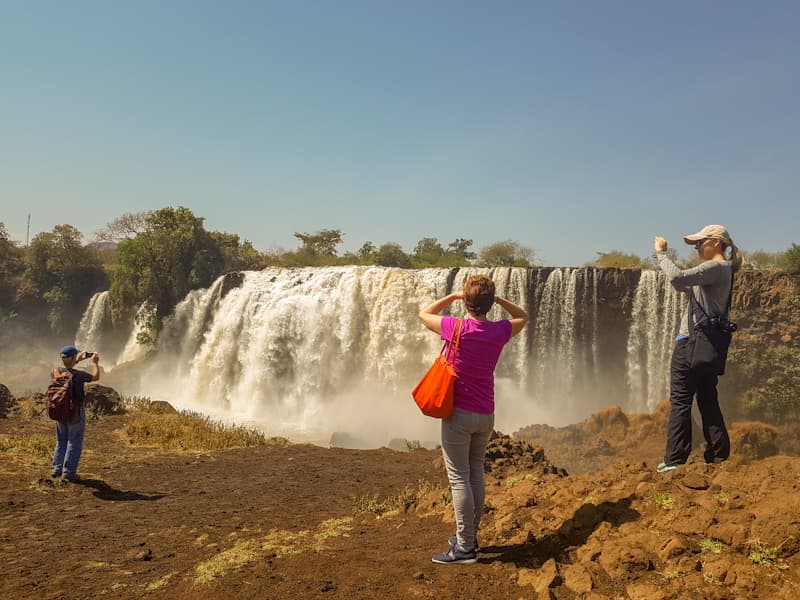 The Blue Nile Falls name ‘water that smokes’ or ‘smoking water’ comes from the sensational sight of the falling waters in the rainy season. It kicks up a thunderous wall of spray as it crashes over a 45-metre-high cliff before being channeled into a frothing gorge.
The Blue Nile Falls name ‘water that smokes’ or ‘smoking water’ comes from the sensational sight of the falling waters in the rainy season. It kicks up a thunderous wall of spray as it crashes over a 45-metre-high cliff before being channeled into a frothing gorge.
Location – The Blue Nile Falls is 32 km or 20 miles far from the city of Bahir Dar in the southwest direction. Tis Isat (Blue Nile Falls) is 520 km north of Addis Ababa on the new road via Bichena, Mertule Mariam, and Mota towns.
Size (Dimensions) of the Blue Nile Falls – The height of the water falls at the Blue Nile Falls is 42 meters (about 138 feet). The water volume at the Blue Nile Falls depends on the season. During the dry season (Mid-September to beginning of June), the water volume gets very low. But, in the rainy seasons of June to September, the waters of the Blue Nile Falls cover about 400 meters (1312 feet) wide.
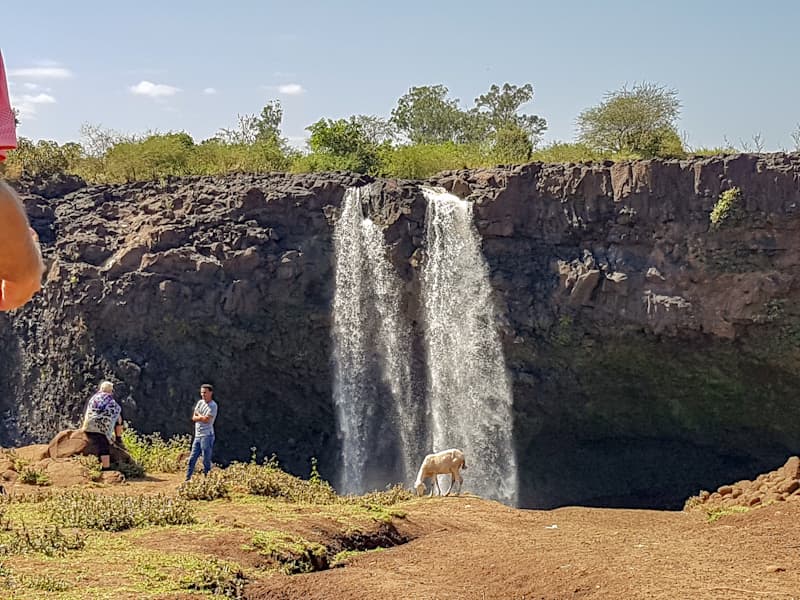 The Blue Nile Falls is one of Ethiopia’s best known tourist attractions near Bahir Dar together with the island monasteries of Lake Tana.
The Blue Nile Falls is one of Ethiopia’s best known tourist attractions near Bahir Dar together with the island monasteries of Lake Tana.
Historical Mentions (Cites) of the Blue Nile Gorge
The famous Scottish traveler and writer James Bruce of Kinnaird is cited as the first European to visit the Blue Nile Falls. James Bruce was on a mission in the 1770s to discover the source of the Blue Nile River. He followed the Blue Nile River courses upstream starting from Egypt, Sudan, and Ethiopia.
James Bruce described the Blue Nile Falls as: ‘a magnificent sight, that ages, added to the greatest length of human life, would not efface or eradicate from my memory’. James Bruce’s travel story was published in 1790 in his publication - "Travels to Discover the Source of the Nile..."
Another convincing story declares Fr Pedro Paez to see the Blue Nile Gorge in 1618. As the Portuguese Jesuit Missionaries were in the Northern Ethiopia in the 17th Century AD, it is acceptable if Pedro Paez takes the credit for it.
The fact that the Jesuit Missionaries built a stone bridge over the Blue Nile River (very close to the Blue Nile Falls) in 1620 makes the later version of the discovery of the Blue Nile Falls more plausible. The bridge is still in use and known as “the Portuguese Bridge”.
Following are frequently asked questions about the Blue Nile Falls and answers by an Ethiopian Tour Operator and Guide – Muluken Girma
Get quick answers for the following questions and more: -
• Why are Blue Nile River and Blue Nile Falls famous or important?
• Where does the Blue Nile River start and end?
• How to visit the Blue Nile Falls?
• Why the Blue Nile is called ‘Blue’?
• When to Visit the Blue Nile Falls? The best time to visit the Blue Nile Falls?
• What other sites (tourist attractions) to visit near the Blue Nile Falls?
Why are Blue Nile River and Blue Nile Falls famous or important?
- The Blue Nile Falls is famous for the sheer volume of water falls and its impressive sight during the rainy season in the Ethiopian Highlands.
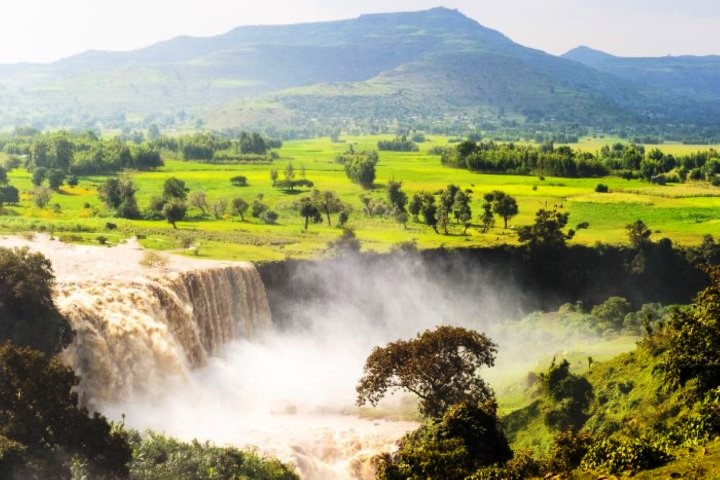
- Blue Nile River, where the Blue Nile Falls is at, provides more than 80% of the water share of the Nile River.
- The Blue Nile is one of the four rivers which surround the ‘Garden of Eden’. The Bible, in the Book of Genesis, denotes the Blue Nile River as ‘Ghion’.
- Blue Nile River is where Africa’s biggest hydroelectric power generating plant is on – The Grand Ethiopian Renaissance Dam (GERD). When fully completed, The Grand Ethiopian Renaissance Dam (GERD) generates 5.15 gigawatts of electricity.
- The Blue Nile Falls is a water fall on the longest running river in the World – The Nile River. The Blue Nile River is known as just the Nile River after it is joined with the White Nile at the Sudanese Capital, Khartoum. It runs for a distance of more than 6,600 kilometers (about 4,100 miles) from Ethiopia’s Lake Tana to Sudan, Egypt to its final destination - the Mediterranean Sea.
- Besides the waters the Blue Nile River provides to Egypt, its gift of rich soils from Ethiopian Highlands is the basis for the ancient Egyptian Civilizations. Don’t you wonder the dirt carried by the Blue Nile and deposited in the lowlands of Egypt was used to make the baked mud bricks for building the Pyramids?
Here is an informative post with important facts on visiting the Great Blue Nile Falls in Ethiopia.
Where does the Blue Nile River start and end?
Publicly, Lake Tana, Ethiopia’s biggest lake, is known to be the source of the Blue Nile River. The outlet where the Blue Nile River exits from Lake Tana is at the town of Bahir Dar, North Ethiopia.
There are different rivers feed Lake Tana itself. And the Blue Nile River is fed by many rivers after it exits from Lake Tana. But, the small holy spring water of Gish Abay is specifically mentioned as the starting point of the Blue Nile River. Gish Abay is 145 km or 90 miles from Bahir Dar; 460 km or 285 miles from Addis Ababa city).
The Blue Nile River ends (empties into) the Mediterranean Sea starting from Ethiopia and crossing Sudan and Egypt.
How to visit the Blue Nile Falls?
If you are planning to visit only the Blue Nile Falls, the easiest access is from the town of Bahir Dar. Drive 32 km southwest of Bahir Dar which takes about 1 hour driving on gravel road.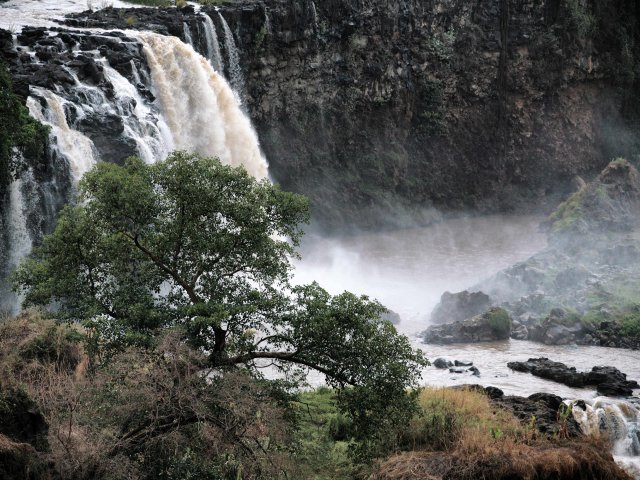
Once you get to the small town of Tis Isat, you have two options to get to the Blue Nile Falls. You can make about 45 minutes to 1 hour walking crossing the historic Portuguese Bridge (the first bridge built on the Blue Nile River in the 1620s).
The other option is to walk for about 10 minutes to the Blue Nile River banks, take a 3-minute boat ride to cross the Blue Nile, and walk for about 10 minutes to get to the Blue Nile Falls.
If you are thinking of visiting the Blue Nile Falls from Addis Ababa, take one of the morning domestic flights of the Ethiopian Airlines to Bahir Dar. Drive from Bahir Dar to the Blue Nile Falls, and get back to Bahir Dar’s Ginbot Haya Airport to fly back to Addis Ababa.
You can create your private tour to visit the Blue Nile Falls and other interesting sites nearby with Merit Ethiopian Experience Tours. Contact us now!
Why the Blue Nile is called ‘Blue’?
The water color of the Blue Nile River is, of course, NOT Blue. It is no wonder that you may ask why it is called ‘Blue’. The color of the Blue Nile River, particularly in the rainy seasons, is turbid because of the thick red soils it carries.
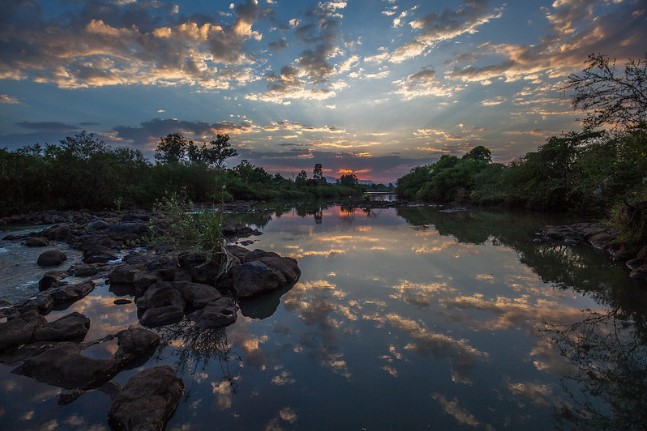 The Blue Nile is more reddish brown than blue. But, in compared with the water colors of the White Nile (more clear and clean), the color of the Blue Nile River is closer to Blue. It is still an open question for speculation.
The Blue Nile is more reddish brown than blue. But, in compared with the water colors of the White Nile (more clear and clean), the color of the Blue Nile River is closer to Blue. It is still an open question for speculation.
Another logical reason for naming the Blue Nile River ‘Blue’ is being able to see the reflection of a clear blue sky in the more clear waters of the Blue Nile River on the dry seasons.
The Amharic name of the Blue Nile River, Tikur Abay (ጥቁር አባይ) meaning Black Nile is a more sensible name for its water colors.
When to Visit the Blue Nile Falls? The best time to visit the Blue Nile Falls?
End of August and beginning of September is the best time of the year to visit the Blue Nile Falls. It is because the water volume is big enough to enjoy the magnificent views. The scenery of the surrounding area is beautiful, lush and decorated with the yellow daisy flower known locally as ‘Adey Abeba’.
The best time of the day to visit the Blue Nile Falls is in the morning with the sunrise or late in the afternoon as the sun set. At these times, you are more probable to get the rainbows with the powerful Blue Nile Falls.
What other sites (tourist attractions) to visit near the Blue Nile Falls?
If you are wondering what other places you can visit together with the Blue Nile Falls; here is a list of interesting tourist destinations nearby.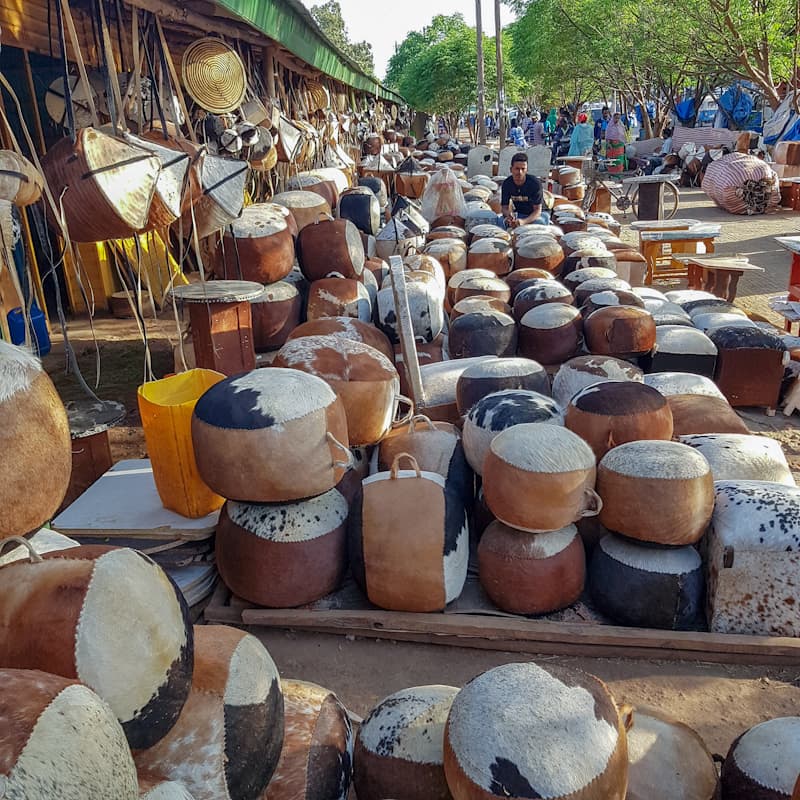
- Bahir Dar City is one of the biggest cities in Ethiopia and the capital of the Amhara Region. The local market of Bahir Dar town is worth visiting. Bahir Dar is famous for its leather hand crafts made out of animal skin. Shop for leather shoes, leather stools stuffed with grass, leather made lunch boxes, belts, and similar Ethiopian hand crafts at the local market of Bahir Dar.
- Lake Tana (ጣና ሃይቅ) with its 20+ still functioning island monasteries of the Ethiopian Orthodox Tewahedo Church is worth visiting. Most of these island monasteries date back to the 16th and 17th Century AD. The island monasteries of Lake Tana are famous for their colorful religious murals on the walls and ceilings.
- Bezawit Hill, 7 km from Bahir Dar City, is a great spot to enjoy the spectacular view of Lake Tana (Ethiopia’s biggest Lake), island monasteries on Lake Tana, Bahir Dar City, and the Blue Nile River as it exits from Lake Tana.
If you are in Addis Ababa for one day, you can make a day trip to visit the Blue Nile River Gorge.
Do you have two days? Merit Ethiopian Experience Tours organizes private to visit the island monasteries of Lake Tana and the Blue Nile River Falls in 2 days/ 1 overnight at Bahir Dar. For your day excursions from Bahir Dar or for transfers from Bahir Dar to Gondar, email Merit Ethiopian Experience Tours.
The private tour to Bahir Dar, Blue Nile Falls, and Lake Tana Monasteries by flight from Addis Ababa is as follows.
Day 1 – Saturday – Fly Addis Ababa – Bahir Dar
Transfer in to Addis Ababa Bole International Airport for your flight ET 186 (08:00 – 09:15) north to Bahir Dar. Drive 32 km southwest of Bahir Dar to Tis Isat town. Walk for about 45 minutes crossing the oldest bridge over Blue Nile River to visit the Blue Nile Falls.
After visiting the falls, take another walking route for about 15 minutes. Cross the Blue Nile River by local metal boat. And walk for 5 more minutes to your vehicle. And drive back to Bahir Dar.
Have lunch at a restaurant by Lake Tana. And drive to the nearby Bezawit Hill to enjoy the panoramic view of Bahir Dar city, Lake Tana and the island monasteries, and the Blue Nile River as it exits from Lake Tana.
Day 2 – Sunday – Fly Bahir Dar – Addis Ababa
After breakfast, take a private boat ride from Bahir Dar to Zeghe Peninsula to visit the island monasteries of Ura Kidane Mihret and Azwa Mariam which both date back to the 14th Century AD and are famous for their beautiful hand painted wall and ceiling paintings from the 16th Century.
You will then head by boat to visit the 16th Kibran Gabriel Monastery (allowed only for men) or to a more recent island monastery of Entos Iyesus.
Before heading back to Bahir Dar city, check out the specific location of the outlet of the Blue Nile River from Lake Tana. Here you may see big hippos.
If time allows, visit the local leather hand crafts market of Bahir Dar for which the city is well known for.
Finally, after late lunch, drive to Bahir Dar Airport and take flight ET 181 (17:25 – 18:40) to Addis Ababa.
Merit Ethiopian Experience Tours [MEET] also organizes two day private trips from Addis Ababa including visits to the Blue Nile Falls and more.
Did you travel Ethiopia with Merit Ethiopian Experience Tours? Please click below to review us on TripAdvisor.
MERIT ETHIOPIAN EXPERIENCE TOURS [MEET]
Book EthioPerience!

Contact us soon at
Call us on +251-91-136-0488 OR +251-96-307-8067
Drop us a message or chat with us on WhatsApp
Twitter - Follow us on Twitter



